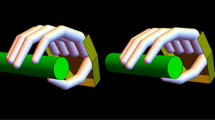Abstract
A problem that has plagued both motor psychologists in studying human behavior, and robot designers in reproducing it, is how to quantify that behavior. It has been argued that kinematic and dynamic models are inadequate for explaining human movement unless they also include both the performance constraints and the objectives that affect the neural and neuromuscular inputs. With a dextrous, multi-fingered hand, multiple grasping solutions are possible. This chapter addresses the question faced by the controller, that of how best to use features of the hand to achieve the task goals, given anticipated object properties and predictable interaction outcomes. The opposition space model takes into account the hand’s ability to apply task-related forces while gathering sensory information, in terms of its precision and power capabilities. By separating implementation details from functional goals, the study of human hand functionality can lead to the design of better dextrous robot hands and their controllers.
“Our hands become extensions of the intellect, for by hand movements the dumb converse, with the specialized fingertips the blind read; and through the written word we learn from the past and transmit to the future.”
—Sterling Bunnell, 1944
Access this chapter
Tax calculation will be finalised at checkout
Purchases are for personal use only
Preview
Unable to display preview. Download preview PDF.
Similar content being viewed by others
Author information
Authors and Affiliations
Editor information
Editors and Affiliations
Rights and permissions
Copyright information
© 1990 Springer-Verlag New York Inc.
About this chapter
Cite this chapter
Iberall, T., MacKenzie, C.L. (1990). Opposition Space and Human Prehension. In: Venkataraman, S.T., Iberall, T. (eds) Dextrous Robot Hands. Springer, New York, NY. https://doi.org/10.1007/978-1-4613-8974-3_2
Download citation
DOI: https://doi.org/10.1007/978-1-4613-8974-3_2
Publisher Name: Springer, New York, NY
Print ISBN: 978-1-4613-8976-7
Online ISBN: 978-1-4613-8974-3
eBook Packages: Springer Book Archive




